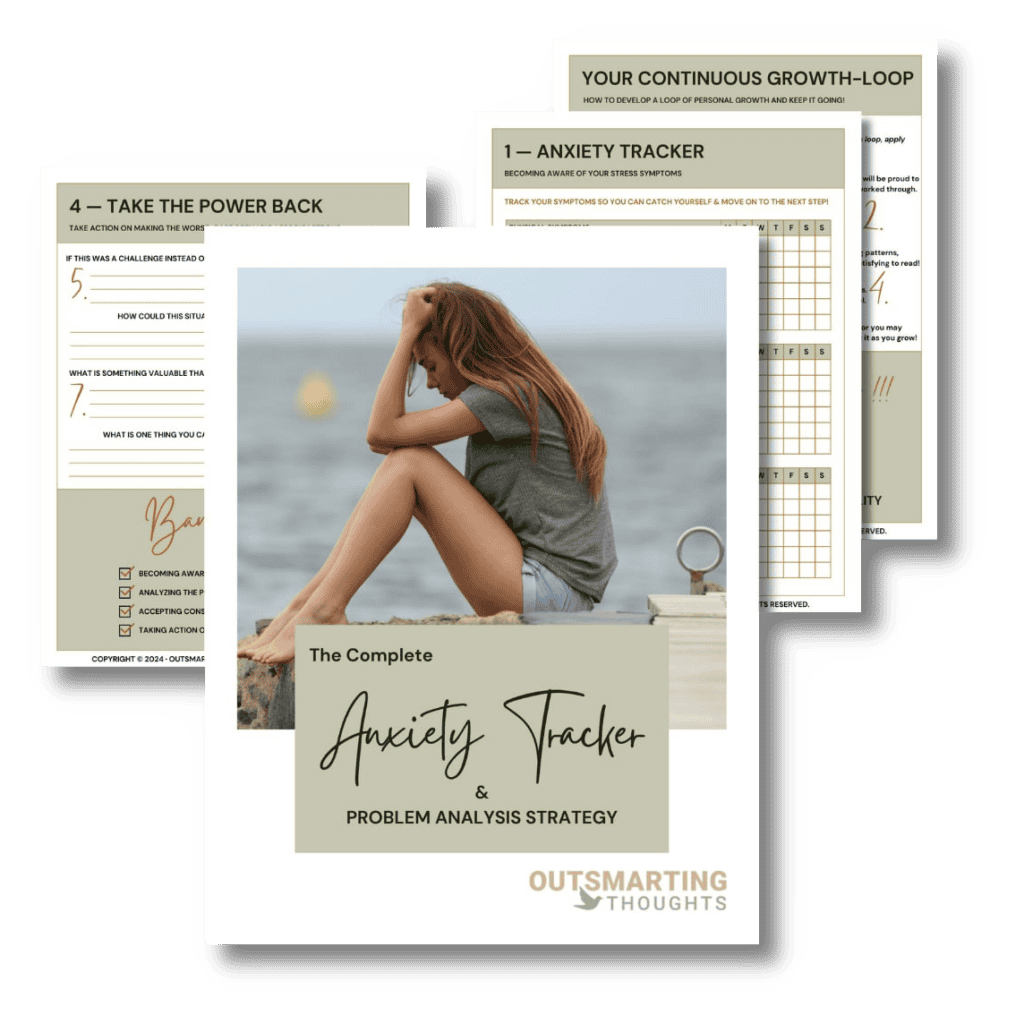Wanna know how to be assertive without feeling like you’re the bad guy? We’re gonna explore 4 steps to master conflict non-violently & develop the skill of handling tough conversations. Let’s go!
Navigating tough conversations can be extremely dysregulating and terrifying. I know what it’s like to be WORRIED SICK that what YOU have to say is unwelcome, unwanted, and the start of an ever-escalating shitshow. Fundamentally however, assertiveness is truly about having healthy boundaries and having the right to express them. So, how do we express ourselves without everything escalating into aggression and boundaryless conflict? Let’s dive in and see how we can assert ourselves without becoming the asshole.
What you’re going to learn is how to be assertive in a non-violent matter. You’re going to walk through a 4-step strategy that covers ‘knowing what you want’ & ‘making peace with negative outcomes’, together with ‘preparing the hard conversation’ & actually ‘communicating your boundary without aggression’.
After you have learned how to walk through these steps you will be able to develop the skill of asserting yourself. If you’re one of those brave ones who dare to continue fighting for the right thing without wanting to harm anyone, then this is the strategy for you. Let’s make you feel strong & kick-ass confident by learning how to speak up.
This post is all about how to be assertive without feeling like you’re the bad guy.
How To Be Assertive
Okay, let’s start by pointing out a harsh reality of our day and age: Tragically enough, assertiveness is always associated with being aggressive. If you’re the type of person who prioritizes being KIND & ‘always doing the right thing‘, then this false belief can totally be used against you (and most probably, it already has been). It’s very understandable to fall for, because: Nobody wants to be aggressive!
To understand the difference between assertiveness & aggression, we have to factor in CONSCIOUS CHOICE. Aggression means that you do not leave the other person the right to have another choice, opinion, or perspective. Assertiveness, on the other hand, is stating what you want, persuading & arguing your case, but also being able to handle another outcome. In order to be considered ‘the good guy’, it’s essential to leave the other’s autonomy, innocence, beliefs & opinions intact.
Unfortunately, being assertive is scapegoated HARD by narcissistic individuals, because they hold the firm conviction that you are not allowed to have boundaries. (Projection, am I right?) From their perspective, the truth and their opinion are identical, you are their property to be owned, and your opposing perspective is a THREAT to their system (Ahem, yes, that’s 100% aggression). They will make you the problem for everything that isn’t going right, because in their perspective, you are. ‘How dare you have that opinion? How dare you contradict me?‘
Be Careful For The Self-Doubt Caused By Toxic Personalities
A narcissist will keep you second-guessing about ‘you being the bad guy‘ by guilt-tripping you for having opinions and boundaries, playing in on your shame, and blaming you for all the things that went wrong. In case you’re in the horrible situation where you second-guess yourself about being the asshole: analyze the level of aggression of yourself and the other individual, by observing how many choices are left for opposing opinions & beliefs. The tell of a narcissist is that they can handle zero.
It’s important to keep in mind how toxic the individual is that you are trying to assert a boundary to, as the chances to actually succeed are getting slimmer with the rate of dysfunctionality in the individual. Usually, it’s safer to not argue with the narcissist and leave asap. If you don’t have that option it’s probably still better to ‘go gray rock’, because asserting boundaries to narcissists is an almost impossible extreme sport in itself. Often it’s because of having these toxic personalities in your life that you’re conditioned into believing having boundaries is a bad thing anyway!
The Right Thing To Do Is Often NOT The Same As ‘Keeping The Peace’
Especially when you’re used to being treated like shit for speaking up, it can become extremely tempting to flake out on assertiveness and ‘just choose to keep the peace‘ at the cost of yourself. I know how hard it is to speak up when pain seems to be the only result of doing so! However, if you’re trapped in a cycle where you are the one who’s always keeping the peace & avoiding conflicts, while others just keep demanding more and more, then you’re in desperate need of developing the skill of non-violent conflict and learning how to assert boundaries. So let’s go back to the proposition that setting boundaries does not automatically mean doing something bad. Always keep in mind: Asserting boundaries is a key ingredient of a healthy relationship because both parties need their autonomy intact.
Some of our world’s biggest heroes of the last century: Nelson Mandela, MLK, and Gandhi, took a stand and asserted boundaries HARD, even though they were doing so NON-VIOLENTLY. Again, assertiveness is fundamentally about having healthy boundaries and having the right to express them. It’s about daring to make a stand for what is important and what is the right thing to do. Well, you can’t win if the white flag’s out when the war begins. Most of the time when we are the ones that lose out in these tough conversations, it’s because we prioritize ‘being the good guy‘ over doing the hard right thing. So let’s explore how we can break that pattern and dive into the 4 steps of navigating conflict without becoming the asshole.
Step #1: Know What You Want — The Foundation of Assertiveness
So let me ask you a confronting question: How will you be able to communicate what you want, without having clarity about it yourself? If you want to be able to master conflicts and have that hard conversation to assert your boundaries, then of course, the first step in becoming assertive is knowing exactly what you want. Do you believe you are bad for having needs? Do others around you? It is essential that you allow yourself the space to admit these things. What is important to you? What do you dare to take a stand for? Use those negative feelings inside as your guide to uncover your unmet needs. Define precisely what is acceptable and unacceptable for you, so that these boundaries can be expressed in the tough conversation later. What are the natural consequences of crossing boundaries and breaking your non-negotiables?
For instance: Cheating is a very common non-negotiable to have, so, what is the consequence for breaking it? Is it ‘only that your trust will be broken‘ or are you going to leave the marriage? Have as much clarity as possible before the tough conversation is happening. In a healthy relationship, these are already discussed before they even have a chance of blowing up in your face. If you want to read more about how to stay true to yourself, we’ve got your back:
RELATED POST:
How To Avoid Stress: An Overachiever’s Strategy For Staying True To Yourself & Your Emotional Truth
If you come up with surface-level answers, this step is not going to do you justice. Try the ‘Five Times Why Method’ to identify the root of your desires, or just keep digging with ‘why questions’ until you feel that you hit something that resonates as a fundamental need. Connecting with your feelings and needs allows you to identify the core issue without having to overthink every detail. For instance, you don’t want to say to your husband that he has to put away his phone, but instead, let it be known that you crave some quality time together, because what you really want is his energy and attention.
Step #2: Leave Denial & Make Peace With Worst-Case Scenarios
After knowing what you want and what you dare to take a stand for, you are going to have to think through the possible outcomes. Come to terms with the negative outcomes of your conflict, and prepare for the worst. It’s very often our own denial about the disastrous consequences that keep us stuck in overthinking and inaction. Or rather, the consequences and worst-case scenario feel so unbearable, that it makes us unable to move forward. The only thing we really deny is that it is inevitable to express that we are not okay.
To stay with the cheating example, if you expressed cheating as a non-negotiable and you found out your partner broke his word, then not wanting a divorce is not going to solve the issue for you. Of course, you don’t want it, but making the decision about what to do with all of this shit is inevitable. Something NEEDS to be done. Maybe you prefer to go to marriage counseling instead. What is important is that an action is tied to the crossed boundary and that it feels like a step in the right direction. Make an actual action plan, and schedule it, or go into action as soon as you can.
While facing these negative possibilities will be extremely daunting and terrifying, the clarity of your decisions will bring a weird soothing relief. Acceptance also creates a sense of resilience, helping you assert yourself with less fear in the future. To break the paralysis of worst-case scenario denial and come to an actionable decision, you can analyze your problem strategically with some very good questioning techniques. If you struggle with fear of the outcome, try using our problem analysis printable to map out practical steps in moving forward.
Let’s make managing stress & anxiety a little bit more practical by diving into our problem analysis strategy. There’s a solution to every problem! You’ll feel extremely relieved once you have a strategy to get out of the messy parts. We made a printable & anxiety tracker to help you out. Simply fill out the form below:

Want a free
ANXIETY TRACKER &PROBLEM ANALYSIS STRATEGY? Overcome your anxiety and stop overthinking with this
FREE Anxiety Tracker & Problem Analysis Strategy
Simply fill out the form below to get this strategy
delivered straight to your inbox!
Step #3: Mind Prep the Hard Conversation
Last internal step before actually getting into action baby! Going strong! Assertiveness requires a shitton of courage, but funnily enough, your courage also gets stronger when you feel more prepared. Not to sound like Yoda, but good preparation leads to confidence and feelings of certainty, confidence & certainty lead to feeling courageous, and that courage leads to you asserting yourself like a proper badass! Look at it from the opposite scenario too: going into challenging conversations unprepared will most likely result in you feeling overwhelmed & defensive without having any solutions to look forward to. So let’s buckle up and prepare!
This step is all about mentally prepping yourself for ‘going to battle‘. Erase the expectation that conflict will be easy, because it never is. You got this tho. Play out the hard conversation, and write out how you want to direct it. If you would be in charge of the conversation instead of ‘letting it escalate’, what would that look like? Don’t cross over into manipulation here, you should also leave the other party the choice. But prepare and play it out so you can steer it in the right direction. If by now you’re overwhelmed and feel like things are more out of control than you’d prefer, we’ve got you covered:
RELATED POST:
How To Cope With Being Overwhelmed: The Case For Taking Back Control
The Ingredients For A Healthy Assertion
You already have the emotional preparedness and a practical action plan in your pocket by now, so let’s add a final couple of ‘ingredients’ in the mix to make that hard conversation look a little more doable:
- ASSERT YOUR BOUNDARY INTO A SPECIFIC, POSITIVE ACTION REQUEST
When you rephrase your wants & needs into specific, positive action requests, you prevent confusion and resistance from the other party. Sure, it will still be uncomfortable, but the quantity will be less heavy depending on your chosen words. For instance, avoid vague statements such as ‘Stop interrupting me’, and instead use a proposal like ‘Can we agree to let each person finish before speaking?’; This will make the other feel respected, and become less defensive or aggressive. - ANTICIPATE & ACKNOWLEDGE PUSHBACK
And then, as soon as you assert yourself, conflict still arises. What’s important here is to realize that the individual opposite of you has a right to a choice and wants their needs met, just as much as you. Try to transform the pushback into knowledge about what their emotional homework is about. Acknowledging their perspective will produce connection and the goodwill to work things out in everybody’s favor. Use the 5 times why method to unravel their true needs if they let you. Try to see their side, but don’t give away your boundaries. Empathize with their emotions without wavering from your needs. Protect those needs respectfully. - DEVELOP A GO-TO BOUNDARY SENTENCE
A prepared sentence can be a lifeline during heated moments. Just one sentence that communicates your boundary can be repeated over and over if the other party tries to push past it. Remember that NO is a full sentence as well. There is a magnificent book out there that has the perfect formula for doing this step, called ‘Non Violent Communication’ by Marshall Rosenberg. His framework is based on observing, feeling, needing & requesting. You observe & state what’s happening without judgment. Usually, here you tell the trigger of the event. Then you share how it made you feel & highlight the need behind your boundary. You close by politely and firmly asking for what you want.
For instance: When you schedule meetings during our lunch breaks, I feel frustrated because I need that time to recharge. Can we agree to keep lunch hours open for everyone? DONE. No excusing or further explanation necessary, just, state what it is that caused the trouble, explain what you felt, and what you expect and hope to change so it doesn’t happen again. If you must, practice this sentence over and over before actually taking the real deal action.
Step #4: Time For Action! Assert Yourself Without Aggression
And then the moment is there. Time for the hard conversation. Preparation was your armor for the battlefield of communication, now it’s the time to suit up and step on it. Gandhi saw conflict as an opportunity to connect to deeper truths. Maybe you will find something at the other end of your long-awaited conflict too.
Avoid falling into the trap of blame or criticism, even when you’re being provoked. You need to stay focused on your needs and boundaries, as that was the reason for the conflict in the first place. When tensions rise, say ‘I understand you feel strongly about this’, before restating your go-to sentence and boundary. Showing empathy doesn’t mean agreeing, it means understanding the other’s perspective. Succesful resistance isn’t about avoiding conflict, but navigating it with resilience and purpose. Try to see these difficult conversations as opportunities for growth and clarity, both for you and the other party.
How To Be Assertive (Summary)
I’m not gonna sit here and tell you that this process will be easy. Learning this skill is a freakin’ uphill battle. Nonetheless, the process is logical, and the good news is, the more you do it, the stronger you’ll become. Learning this process can transform your life in ways you can’t even imagine right now. I’m dead serious. But I can spoil you already, if you dare to develop this skill, you’ll feel like a strong badass who can handle whatever whenever, and that’s worth your effort, don’t you agree?
This post was all about how to be assertive without feeling like you’re the bad guy.
We aim to help you out as much as possible, but please keep in mind that the content is only for general informational and educational purposes. We offer our services based on independent research and life-experience only, and so our strategies can never serve as a substitute for professional advice. Trust me, we do not have 'everything figured out', are all still huge works in progress, but hey, what works for us, might work for you too! This is allll up for you to decide... It might not work for you, and that's okay, so cherrypick the stuff that resonates and leave the stuff that doesn't, and let's go!








